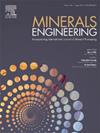The origin of interparticle aggregation: Probing the long-range hydrophobic forces between particles induced by nanobubbles in aqueous solutions
IF 4.9
2区 工程技术
Q1 ENGINEERING, CHEMICAL
引用次数: 0
Abstract
The processes of particle–particle collision, adhesion, and detachment are omnipresent in the solid particle separation and purification processes. Nanobubbles, serving as a critical medium for interactions between particles, play a pivotal role in numerous fields of separation and purification such as mineral flotation, hydrometallurgy, chemical engineering, materials, and more. The elucidation of the principles governing nanobubbles’ involvement in interparticle interactions holds significant implications for enhancing and controlling separation and purification processes. The impact of nanobubbles on interparticle interactions between calcite particles was investigated in this study by measuring the forces between particles with and without nanobubbles and analysing them using DLVO and EDLVO theories. The experimental results demonstrate the occurrence of long-range attractive forces and significant adhesion between particles in the presence of nanobubbles under natural pH and ultrapure water conditions, phenomena that cannot be explained by classical DLVO theory. The generation of long-range hydrophobic attraction at the particle interface due to nanobubbles was confirmed through further EDLVO calculations and modifications, enhancing the stability of particle flocculation. Additionally, for the first time, the entire process from contact to detachment between the “particle-nanobubble” system in atomic force microscopy (AFM) simulations was described by combining experimental force curves with stepwise graphical interpretation. This approach provides valuable guidance for the analysis of bubble and soft matter interactions under AFM. The results of this study indicate that nanobubbles can indirectly alter the hydrophilicity and hydrophobicity of particles, increasing the probability of particle adhesion and reducing the probability of desorption, thereby enhancing the stability of particle flocculation.
粒子间聚集的起源:探究水溶液中纳米气泡诱导的粒子间长程疏水作用力
在固体颗粒分离和提纯过程中,颗粒与颗粒之间的碰撞、粘附和分离过程无处不在。纳米气泡作为颗粒间相互作用的关键介质,在矿物浮选、湿法冶金、化学工程、材料等众多分离和提纯领域发挥着举足轻重的作用。阐明纳米气泡参与颗粒间相互作用的原理,对于加强和控制分离和提纯过程具有重要意义。本研究通过测量有纳米气泡和无纳米气泡颗粒之间的作用力,并利用 DLVO 和 EDLVO 理论进行分析,研究了纳米气泡对方解石颗粒间相互作用的影响。实验结果表明,在自然 pH 值和超纯水条件下,有纳米气泡存在时,颗粒之间会产生长程吸引力和显著的粘附力,而经典的 DLVO 理论无法解释这些现象。通过进一步的 EDLVO 计算和修正,证实了纳米气泡在颗粒界面上产生的长程疏水吸引力,从而增强了颗粒絮凝的稳定性。此外,原子力显微镜(AFM)模拟中的 "颗粒-纳米气泡 "系统从接触到脱离的整个过程,首次通过结合实验力曲线和分步图形解释进行了描述。这种方法为分析原子力显微镜下气泡与软物质的相互作用提供了宝贵的指导。研究结果表明,纳米气泡能间接改变颗粒的亲水性和疏水性,增加颗粒粘附的概率,降低颗粒解吸的概率,从而提高颗粒絮凝的稳定性。
本文章由计算机程序翻译,如有差异,请以英文原文为准。
求助全文
约1分钟内获得全文
求助全文
来源期刊

Minerals Engineering
工程技术-工程:化工
CiteScore
8.70
自引率
18.80%
发文量
519
审稿时长
81 days
期刊介绍:
The purpose of the journal is to provide for the rapid publication of topical papers featuring the latest developments in the allied fields of mineral processing and extractive metallurgy. Its wide ranging coverage of research and practical (operating) topics includes physical separation methods, such as comminution, flotation concentration and dewatering, chemical methods such as bio-, hydro-, and electro-metallurgy, analytical techniques, process control, simulation and instrumentation, and mineralogical aspects of processing. Environmental issues, particularly those pertaining to sustainable development, will also be strongly covered.
 求助内容:
求助内容: 应助结果提醒方式:
应助结果提醒方式:


